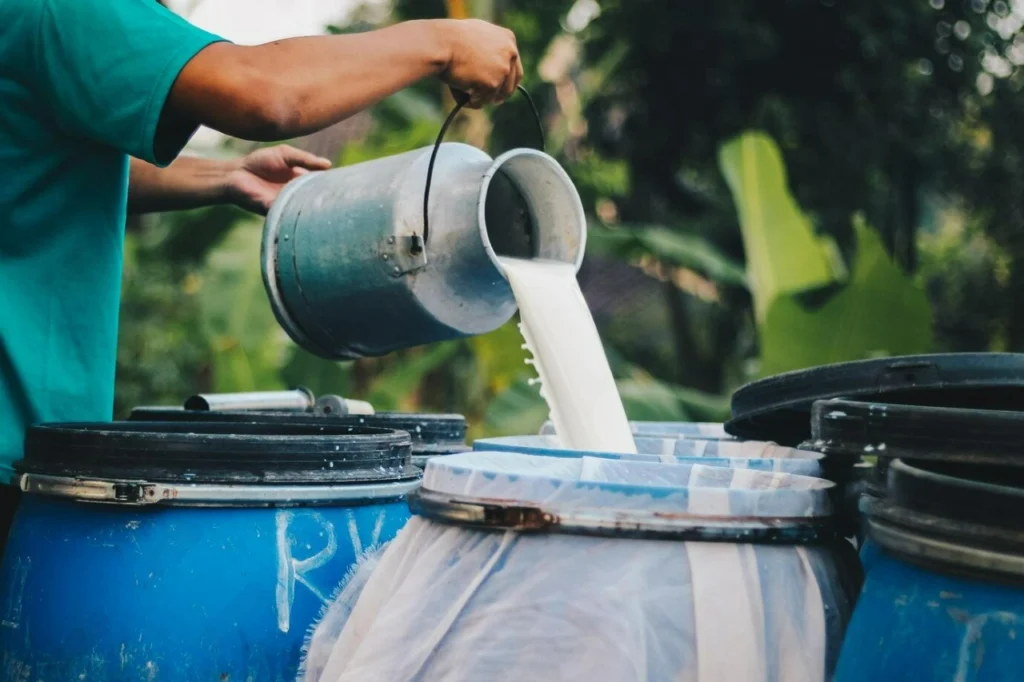The bakery and dairy industries produce large amounts of wastewater daily. This wastewater contains organic matter, oils, fats, and pollutants that can harm the environment if not treated properly.
Treating this wastewater is essential to protect water bodies, maintain hygiene, and comply with environmental regulations.
Dairy industry wastewater presents a particular challenge due to its high organic load, with Biochemical Oxygen Demand (BOD) levels ranging from 1,200 to 5,000 mg/L. This requires advanced treatment processes to meet environmental standards.
In this blog, we will explore the challenges faced in wastewater treatment for the bakery and dairy industries. We will also look at the methods used daily and the solutions that improve the effectiveness of wastewater treatment.
Characteristics of Bakery and Dairy Wastewater

High Organic Content
Both bakery and dairy industries generate a lot of wastewater that contains a very high amount of organic matter.
- Dairy wastewater contains milk solids, proteins, fats, and sugars that increase the overall Biological Oxygen Demand (BOD) and Chemical Oxygen Demand (COD).
- Bakery wastewater has sugars, yeast, oils, & flour residues that also largely contribute to high levels of BOD and COD.
When this wastewater enters lakes or rivers, it considerably reduces the levels of oxygen in the water and thus harms the aquatic creatures considerably.
Fluctuating Levels of pH
The pH level of wastewater can vary to a large extent.
- In the process of dairy processing, certain cleaning agents are being used for washing the equipment and this can make the wastewater highly alkaline.
- In bakery industries, several processes produce acidic wastewater.
As the treatment of wastewater requires a stable pH, constant monitoring as well as adjustments are very necessary to ensure effective wastewater treatment.
Presence of Fats, Oils & Grease (FOG)
Bakery and dairy wastewater contain considerably high amounts of fats, oils, and grease which is often referred to as FOG.
- FOG can clog pipes and pumps, leading to major blockages in wastewater treatment plants.
- If not removed properly, FOG likely affects the various biological treatment processes by forming a considerably thick layer on the surface and it prevents the transfer of oxygen.
Thus, the removal of FOG is considered to be one of the very crucial steps in the process of wastewater treatment.
High Nutrient Load (Nitrogen & Phosphorous)
- Dairy wastewater likely contains considerably high levels of nitrogen and phosphorous, various dairy products, and milk.
- When the wastewater from dairies and bakeries is discharged into water bodies, the various nutrients can cause the process of eutrophication. It usually leads to excessive growth of algae.
- Algae blooms considerably reduce the level of oxygen present in the water. Thus, it harms fish and several other aquatic lives.
Proper nutrient removal methods are required to prevent environmental damage to a large extent.
Challenges in Wastewater Treatment
- Handling High COD and BOD Levels
High COD and BOD levels likely indicate that the wastewater contains a high amount of organic pollution.
- Treating this wastewater requires strong biological treatment methods, like as activated sludge systems.
- In case the wastewater is not properly treated, the discharge can pollute lakes and rivers, like as activated sludge systems.
- Managing pH Variations
- Since dairy and bakery wastewater has varying levels of pH, treatment plants must constantly monitor & adjust the pH.
- If pH happens to be too low (acidic) or too high (alkaline), it can damage treatment equipment and reduce the overall efficiency of biological treatment processes.
- Removing Fats, Oils, and Grease (FOG)
- FOG often accumulates on treatment equipment. It happens to reduce the overall efficiency of the treatment equipment.
- It can hinder biological treatment processes by coating bacteria and preventing them from breaking down the various organic matter present in the wastewater.
- Special dissolved air flotation (DAF) units or grease traps are required for the removal of FOG.
- Handling High Nutrient Loads
- High phosphorous and nitrogen levels in dairy wastewater require advanced nutrient removal techniques.
- In case not removed, these particular nutrients contribute to water pollution and algal blooms in natural water bodies.
- Treating Large Volumes of Wastewater
- Bakery and dairy industries generate large amounts of wastewater daily.
- Treatment plants must be well-designed to handle fluctuations in wastewater volume, especially during the peak seasons of production.
Common Challenges in Dairy Wastewater Treatment
- High Content of Fat
- Dairy wastewater is found to contain significant amounts of fat.
- In case it is not removed properly, it can end up clogging pipes & significantly reduce the efficiency of the treatment.
- Dissolved air floatation (DAF) systems are often needed as an effective way of removing fat.
- Seasonal Variations in Production
- Processing of milk largely varies throughout the year and it affects wastewater volume.
- The treatment systems must be flexible enough to handle all these fluctuations very efficiently.
Common Challenges in Bakery Wastewater Treatment
- High Content of Sugar
- Sugar present in the wastewater can promote excessive growth of microorganisms, leading to sludge bulking in the treatment systems.
- Proper biological treatment control is very necessary to manage the breakdown of sugar effectively.
- Presence of a Specific Matter
- Food materials and flour increase suspended solids in wastewater.
- Effective sedimentation and filtration methods are required to remove these particular particles.
Effluent Processes of Treatment
- Primary Treatment
The first stage of treatment done by us involves the following:
- Screening – It removes large particles like solid waste and food scraps.
- Sedimentation – It allows heavier particles to settle towards the bottom of the tanks.
- Grease and Oil Separation – Using grease traps helps in removing oils and fats.
- Secondary Treatment or Biological Treatment
This particular process is aimed at removing dissolved organic matter using microorganisms and bacteria. The various common methods include the following:
- Activated Sludge Process (ASP) – Uses bacteria to break down various types of organic waste.
- Biofilm Reactors – Microorganisms grow on surfaces as well as break down pollutants.
For dairy wastewater treatment, maintaining proper conditions for microbial activity is very crucial to break down milk fats and solids.
- Tertiary Treatment or Advanced Treatment
- This process involves membrane filtration, UV disinfection, or chemical treatments.
- It ensures that wastewater meets discharge standards before being released into the environment.
Proven Solutions for Wastewater Treatment
- Membrane Bioreactors (MBRs)
- These combine biological treatment with membrane filtration.
- These provide high-efficiency treatment but usually require regular maintenance.
- Anaerobic Digestion
- Breaks down the organic matter without oxygen and produces biogas as an ultimate byproduct.
- It helps in energy recovery from wastewater.
- Advanced Oxidation Processes (AOPs)
- The usage of highly reactive chemicals is instrumental in breaking down pollutants.
- It is effective for the removal of hard-to-treat organic compounds.
Our world-class facility and experienced team of professionals at Northamps make us the most trusted company in treating wastewater from the bakery and dairy industries.
Conclusion
Bakery and dairy wastewater treatment are essential for removing pollutants and protecting the environment. These processes handle high organic content, variable pH levels, and oils, fats, and grease. Dairy wastewater treatment, in particular, is crucial for removing harmful substances from wastewater and ensuring compliance with environmental standards.
An effective dairy industry effluent treatment plant must be well-maintained and adaptable to changing wastewater characteristics. Modern treatment methods such as anaerobic digestion, membrane bioreactors, and dissolved air flotation provide the most efficient solutions. Many industries are also focusing on reducing wastewater generation at the source.
Northamps offers advanced wastewater treatment solutions for the bakery and dairy industries. Our solutions meet environmental standards while promoting sustainability. We ensure that dairy wastewater treatment processes are efficient and reliable for a cleaner, safer environment.


